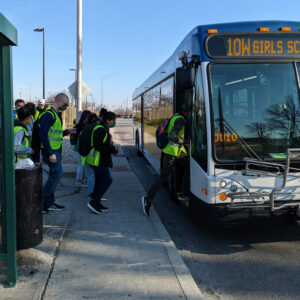contributed by Keith Fox, program manager at Easterseals Crossroads; article originally seen in Special Needs Living magazine, June 2023
Public transportation makes it possible for all people to move around the city to work, attend appointments, grocery shop and participate in social activities. The bus system is timed to allow for transfers from one route to another without major interruption.
 Benefits of Using Public Transportation
Benefits of Using Public Transportation
Public transportation is a safe way to travel, and all public buses have safety systems in place including video cameras inside the buses and on the exterior parameters.
All public busses are equipped with a wheelchair lift and there are areas in the front of the bus for wheelchairs with secured fastening systems. Each bus has an area in the front for individuals with disabilities as well as older people to sit without having to maneuver down the small bus walkway. This designated area provides the rider with the opportunity to seek out assistance from other riders and the driver while in route or when entering / exiting the bus.
Public bus schedules are consistent and reliable and run routes frequently providing riders additional flexibility in planning routes. The use of technology increases riders’ real time experiences through the ability to track specific buses to learn of routes, locations and changes.
When traveling on a public bus a rider may find time to relax and even work if traveling with a phone or tablet since many busses are equipped with USB ports to charge devices. This provides riders the opportunity to continue to be productive during travel time.
Riding public transportation can give riders a sense of belonging. Riders may also learn about other areas of the city, landmarks, people, places and things. Riding public transportation when traveling in a new city provides an opportunity to see new sights.
The use of public transportation is an effective cost saving strategy that is not available through use of many rideshare programs, door to door paratransit systems and personal transportation. Using public transportation can result in some savings for people when considering costs of driving a car (gasoline, insurance, parking, etc.).
Challenges of Using Public Transportation
While the benefits can outweigh the obstacles and challenges of public transportation, there are some worth mentioning.
- When utilizing public transportation, an individual must be at a bus stop at the appropriate time.
- If the marquee inside the bus is not working properly and not luminating the routes and stops and/or the voice activation is not working, a rider will need to resort to landmarks to pull the cord to signal the bus to stop when appropriate.
- The time spent on a public bus may mean it takes longer to get to a destination because of the route traveled and the transfer involved.
Overcoming Challenges of Public Transportation
To overcome some of the obstacles and challenges involved in public transportation, a rider must become aware of routes, landmarks and travel time.
Training is key, and perseverance can dictate results. Travel training is an important and necessary step in eliminating fears and anxiety. The unknown can create anxiety, but training, knowledge and experience can contribute to knowledge and empowerment.
Technology is a great way to overcome many challenges of public transportation. The use of GPS, transit apps, pictures and time cues are a part of everyday life for many individuals and these factors can be used to master public transportation.
Public transportation companies post information in real time on websites with information pertaining to schedules and detours that can affect rides. There are some free apps that can be downloaded to track the bus in real time. A couple of examples are My Transit App or My Stop App.
The Wayfinder App is a cost to users, but it has a programmed route that offers the capability of voice and use of landmarks during travel. This app is a great option for individuals whose travel training is limited or if the individual may need constant prompting.
Many social service agencies for individuals with disabilities have mobility training specialists or other professional staff who can provide training. This training consists of real time coaching, picture cues, technology and landmark identification. The goal is for the individual to be able to travel to and from work.
Paying for Public Transportation
There are several options available to pay to access the public transportation system. Exact change on the bus can be used by inserting coins or dollars in the on-board bus pay and pass system. This option only allows for exact change and a ticket that is purchased will print out to be used for the remainder of the tickets valid time and date. Tickets can also be purchased at the transit store located at the main hub or at the Indianapolis airport. Online accounts can be created to obtain a public bus ID, called MY KEY. Funds can be added to MY KEY; when used to enter a bus, costs are deducted from the card.
“Learning the public transportation system was the best thing for our son it allowed him to be independent, his self-confidence increased, and he had the opportunity to participate in activities with his friends.”- Project SEARCH intern parent.
About the Author
Keith Fox, program manager at Easterseals Crossroads, has been training individuals with disabilities on public transportation for 24 years. Many individuals with whom he works have never used public transportation, which can create uncertainty for the individual and with his/her family. “Creating individualized plans help alleviate anxiety. When families see their loved ones reach new independence with transportation, there can be an overall sense of pride and comfort in having a reliable way of getting around the city independently. This directly increases the individual’s self-esteem, self-confidence and self-determination. This can greatly contribute to empowerment and advocacy for people with disabilities,” said Keith.



